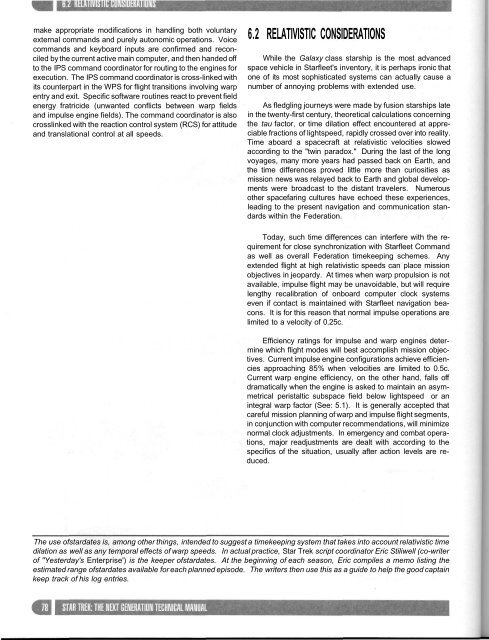franchise-star-trek-tng-technical-manual1
franchise-star-trek-tng-technical-manual1
franchise-star-trek-tng-technical-manual1
Create successful ePaper yourself
Turn your PDF publications into a flip-book with our unique Google optimized e-Paper software.
make appropriate modifications in handling both voluntaryexternal commands and purely autonomic operations. Voicecommands and keyboard inputs are confirmed and reconciledby the current active main computer, and then handed offto the IPS command coordinator for routing to the engines forexecution. The IPS command coordinator is cross-linked withits counterpart in the WPS for flight transitions involving warpentry and exit. Specific software routines react to prevent fieldenergy fratricide (unwanted conflicts between warp fieldsand impulse engine fields). The command coordinator is alsocrosslinked with the reaction control system (RCS) for attitudeand translational control at all speeds.6.2 RELATIVISTIC CONSIDERATIONSWhile the Galaxy class <strong>star</strong>ship is the most advancedspace vehicle in Starfleet's inventory, it is perhaps ironic thatone of its most sophisticated systems can actually cause anumber of annoying problems with extended use.As fledgling journeys were made by fusion <strong>star</strong>ships latein the twenty-first century, theoretical calculations concerningthe tau factor, or time dilation effect encountered at appreciablefractions of lightspeed, rapidly crossed over into reality.Time aboard a spacecraft at relativistic velocities slowedaccording to the "twin paradox." During the last of the longvoyages, many more years had passed back on Earth, andthe time differences proved little more than curiosities asmission news was relayed back to Earth and global developmentswere broadcast to the distant travelers. Numerousother spacefaring cultures have echoed these experiences,leading to the present navigation and communication standardswithin the Federation.Today, such time differences can interfere with the requirementfor close synchronization with Starfleet Commandas well as overall Federation timekeeping schemes. Anyextended flight at high relativistic speeds can place missionobjectives in jeopardy. At times when warp propulsion is notavailable, impulse flight may be unavoidable, but will requirelengthy recalibration of onboard computer clock systemseven if contact is maintained with Starfleet navigation beacons.It is for this reason that normal impulse operations arelimited to a velocity of 0.25c.Efficiency ratings for impulse and warp engines determinewhich flight modes will best accomplish mission objectives.Current impulse engine configurations achieve efficienciesapproaching 85% when velocities are limited to 0.5c.Current warp engine efficiency, on the other hand, falls offdramatically when the engine is asked to maintain an asymmetricalperistaltic subspace field below lightspeed or anintegral warp factor (See: 5.1). It is generally accepted thatcareful mission planning of warp and impulse flight segments,in conjunction with computer recommendations, will minimizenormal clock adjustments. In emergency and combat operations,major readjustments are dealt with according to thespecifics of the situation, usually after action levels are reduced.The use of<strong>star</strong>dates is, among other things, intended to suggest a timekeeping system that takes into account relativistic timedilation as well as any temporal effects of warp speeds. In actual practice, Star Trek script coordinator Eric Stiliwell (co-writerof "Yesterday's Enterprise') is the keeper of<strong>star</strong>dates. At the beginning of each season, Eric compiles a memo listing theestimated range of<strong>star</strong>dates available for each planned episode. The writers then use this as a guide to help the good captainkeep track of his log entries.


